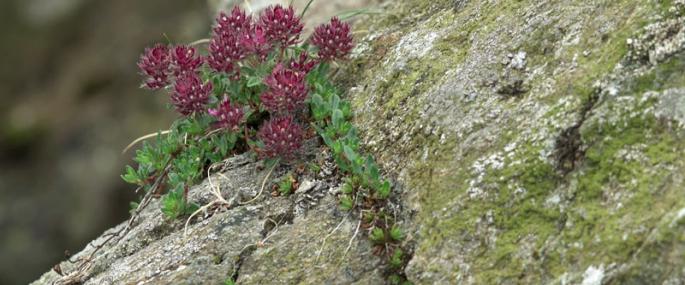Ground-ivy
Despite its name, Ground-ivy is actually a member of the dead-nettle family and is an evergreen, creeping plant of woodlands, hedgerows and damp ground. It often forms clumps, spreading by means of overground runners that frequently root. It has a strong smell and violet flowers that appear from March until June.
The Wildlife Trusts manage many nature reserves for the benefit of all kinds of wildlife, including many different species of plants. But these precious sites are under threat from development, intensive agricultural practices and climate change. You can help by supporting your local Trust and becoming a member; you'll find out about exciting wildlife happenings, events on your doorstep and volunteering opportunities, and be helping local wildlife along the way.
Red Dead-nettle
Red Dead-nettle is a common plant of roadside verges, waste grounds and field edges - anywhere the ground has been disturbed or cultivated. Like Yellow Archangel and other members of the 'dead'-nettle family, it doesn't have stinging leaves. Its crimson flowers appear from March to October.
Although they sometimes don't look especially wildlife-friendly, our roadside verges and waste grounds can provide valuable habitats for all kinds of plants and animals. The Wildlife Trusts get involved in different projects to help make these places as beneficial for wildlife as possible. We have a vision of a 'Living Landscape': a network of habitats and wildlife corridors across town and country, which are good for both wildlife and people. You can support this greener vision for the future by joining your local Wildlife Trust.

White Dead-nettle
White Dead-nettle is a common plant of roadside verges, waste grounds and grassy banks - anywhere the ground has been disturbed. Like Yellow Archangel and other members of the 'dead'-nettle family, it doesn't have stinging leaves. Its white flowers appear from March right the way through to December.
Although they sometimes don't look especially wildlife-friendly, our roadside verges and waste grounds can provide valuable habitats for all kinds of plants and animals. The Wildlife Trusts get involved in different projects to help make these places as beneficial for wildlife as possible. We have a vision of a 'Living Landscape': a network of habitats and wildlife corridors across town and country, which are good for both wildlife and people. You can support this greener vision for the future by joining your local Wildlife Trust.
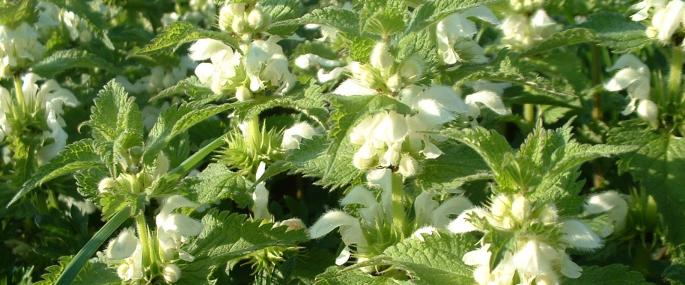
Hedge Woundwort
Growing in hedgerows, woodlands and roadside verges, Hedge Woundwort is a common, perhaps unremarkable, plant with one defining feature - its unpleasant and astringent smell. This smell is particularly apparent when the plant is crushed. Magenta flowers appear between June and October and are pollinated by bees. Once the seed is dispersed, the plant spreads vigorously using its underground rhizomes (stems).
Our hedgerows support all kinds of wildlife, providing vital food and shelter. But these habitats are disappearing with the intensification of agriculture. The Wildlife Trusts are working closely with farmers, landowners and developers to promote wildlife-friendly practices, such as planting hedges and leaving field margins. We have a vision of a 'Living Landscape': a network of habitats and wildlife corridors across town and country, which are good for both wildlife and people. You can support this greener vision for the future by joining your local Wildlife Trust.
Yellow Archangel
The flowers of Yellow Archangel come into bloom just as the Bluebells are fading, replacing the blue carpet of a spring woodland with a golden-yellow one. A plant of ancient woodlands and hedgerows, Yellow Archangel may well have got its common name from its virtue of not stinging, despite being part of the 'dead'-nettle family.
The Wildlife Trusts manage many woodland nature reserves sympathetically for a range of spring flowers, from bold Yellow Archangel to fragrant Ramsons, showy Bluebells to delicate Wood Anemones. A mix of coppicing, scrub-cutting and ride maintenance open up the woodland floor to the sun, helping many flowers and plants to thrive. You can help too: volunteer for your local Wildlife Trust and you could be involved in everything from traditional forest crafts to raising awareness about woodland wildlife.
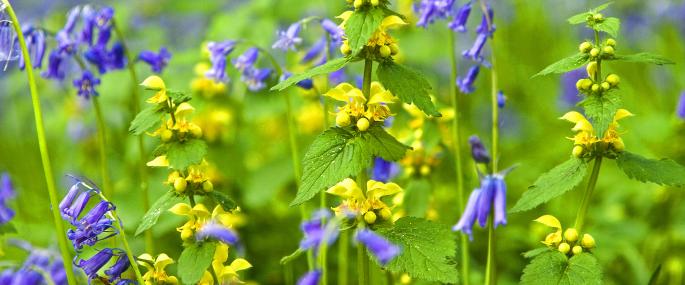
Black Horehound
Growing in hedgerows, roadside verges and waste grounds, Black Horehound is a common, perhaps unremarkable, plant with one defining feature - its pungent, rotten smell. This smell, particularly apparent when the leaves are crushed, keeps herbivores away and gives it a local name of 'Stinking Roger' in some places. It flowers between June and September.
Although they sometimes don't look especially wildlife-friendly, our roadside verges and waste grounds can provide valuable habitats for all kinds of plants and animals from Black Horehound to Black Redstarts. The Wildlife Trusts get involved in different projects to help make these places as beneficial for wildlife as possible. We have a vision of a 'Living Landscape': a network of habitats and wildlife corridors across town and country, which are good for both wildlife and people. You can support this greener vision for the future by joining your local Wildlife Trust.
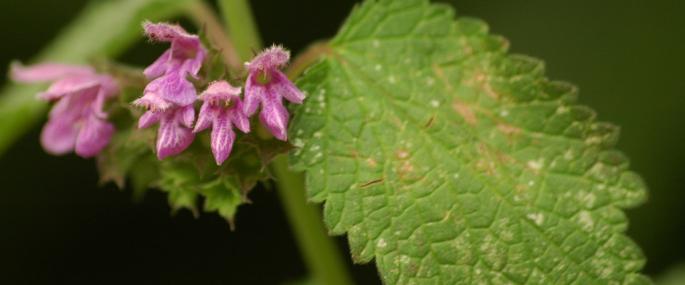
Selfheal
Selfheal can be seen creeping through the short turf of a grassland or the uncut grass of a woodland clearing or roadside verge; it can even pop up in lawns that haven't been treated with chemicals. Its clusters of violet flowers appear from June to October and provide a nectar source for bees and wasps.
Some of our most abundant species are often treated as 'weeds' when they appear in the garden. Yet they can be extremely beneficial to wildlife, providing food for nectar-loving insects and shelter for minibeasts. Try leaving wilder areas in your garden, such as patches of Selfheal in your lawn and Stinging Nettles near the compost heap, and see who comes to visit... To find out more about wildlife-friendly gardening, visit our Wild About Gardens website: a joint initiative with the RHS, there's plenty of facts and tips to get you started.
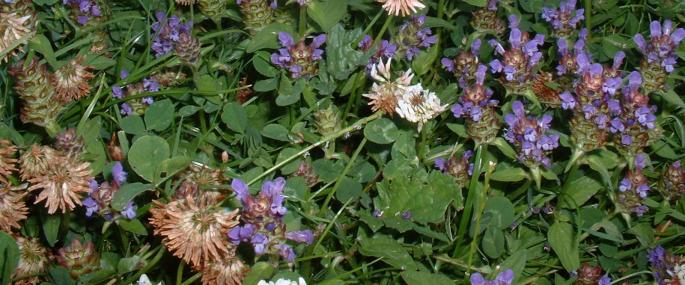
Wild Marjoram
Oregano is a classic and aromatic Mediterranean herb often used in cooking. But did you know that it's the same species as our Wild Marjoram? In the cooler climate of the UK, Wild Marjoram develops a slightly different scent, but it is still an excellent herb for use in the kitchen. It can be found growing on chalk and limestone grasslands in summer, its pinky flowers appearing between June and September.
Like many of our native plants, Wild Marjoram is an excellent source of nectar and pollen for all kinds of insects including bumblebees and butterflies. To encourage wildlife into your garden, try planting native flower species in your borders to provide a 'nectar-cafe'; if you plant herbs, use can also use them for your cooking! To find out more about wildlife-friendly gardening, visit our Wild About Gardens website: a joint initiative with the RHS, there's plenty of facts and tips to get you started.
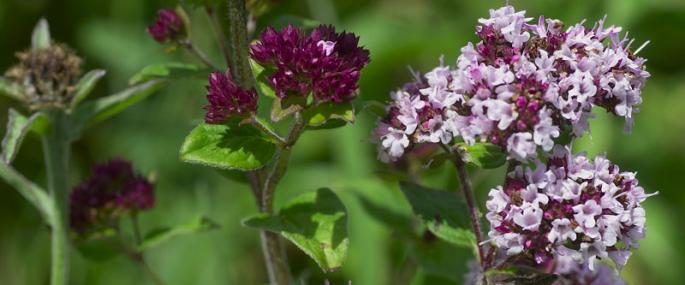
Water Mint
There are about 14 or 15 species or hybrids of mint growing in the UK, most of which have very aromatic leaves. Water Mint prefers damp habitats and grows in water, making it a good choice for wildlife ponds and bog gardens. Its leaves can be used in the same way as other mints, flavouring cooking and drinks. It flowers from July to October and spreads vigorously using its creeping runners.
Human activity, including the drainage of land for agriculture and development, has resulted in the disappearance of many of the UK's wetlands. The Wildlife Trusts are working closely with planners, developers and farmers to ensure our wetlands are protected. You can help too: add native plants and flowers, such as Water Mint, to a wildlife-friendly pond and its margins, and provide shelter for amphibians and nectar for insects. In partnership with the RHS, The Wildlife Trusts' Wild About Gardens initiative can help you plan your wildlife garden.
Wild Thyme
Wild Thyme is by far the most widespread and abundant of the thyme species. Walk across a chalk grassland in summer and its fragrance will punctuate the warm air around you - a delightful, sensory experience. Often forming mats low to the ground, it can also be found growing in short-turfed pastures and meadows, and on cliffs, walls and rocky places.
Areas of rare and unique wildlife, chalk grasslands have been likened to rainforest for the diversity of species they hold. But they are being lost at an alarming rate due to changes in land use causing the decline of grazing: it's estimated that we've lost 80% of our chalk grassland over the last 60 years. The Wildlife Trusts manage many grassland nature reserves for the benefit of the rare wildlife they hold. You can help too: volunteer for your local Wildlife Trust and you could be involved in everything from scrub-cutting to stockwatching.
